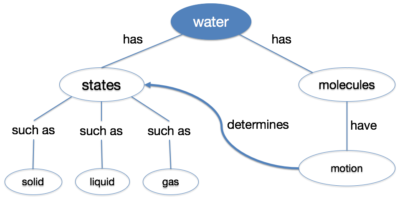 Concept maps can come in many forms, but the simplest consist of solid shapes labeled as concepts, and connections between them explicitly labeling the relationship.
Concept maps can come in many forms, but the simplest consist of solid shapes labeled as concepts, and connections between them explicitly labeling the relationship.
Asking your learners to develop their own concept maps to depict their understandings can be a powerful tool for learning–it can can help support the construction of meaning, and create a space for learners to reflect upon what they actually know. Mapping that focuses on the links amongst concepts can help develop higher-level reasoning skills by encouraging learners to identify and organize relationships.
Consider sharing these benefits with your learners so they understand the potential of concept maps. Furthermore, consider using exemplars that apply to your course content or have learners work together to construct maps. Remind them that more is not always better – a succinct yet deep concept map can convey more understanding that an overly worked less selective map.
CATLR Tips
- Use concept maps to begin exploration of material and its relationships, not to end it. Having students generate their own concept maps is a powerful way to activate prior knowledge and generate motivation among learners. As an educator, however, it can be tempting to generate the “right” concept map and show it to learners after they’ve made theirs. This can actually detract from their learning, as they can discard the linkages they’ve already made within their own knowledge and simply try to memorize yours. Instead, just encourage that they keep building from where they started.
- As with any activity, learners should know the instructional purpose behind a concept map activity. Using concept mapping as an early diagnostic activity and also as a text review activity are both excellent reasons to ask learners to make visible what they’ve already learned.
References
Kinchin, I. M. (2014). Concept mapping as a learning tool in higher education: A critical analysis of recent reviews. The Journal of Continuing Higher Education, 62(1), 39-49.
